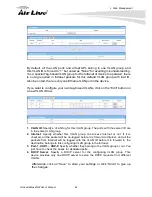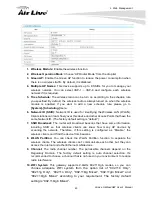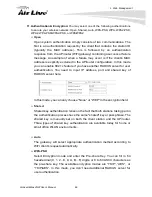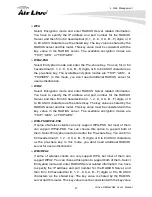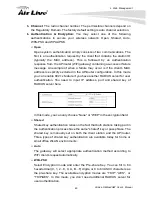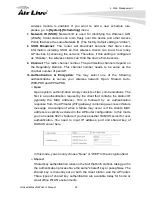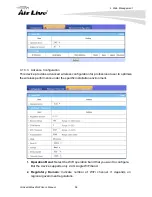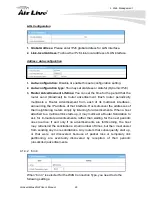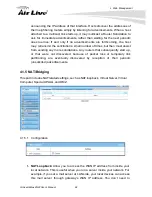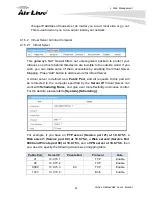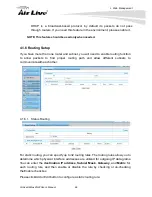
4.
Web Management
AirLive AirMax4GW User’s Manual
52
wireless module is enabled. If you want to add a new schedule rule,
please go to
[System]-[Scheduling]
menu.
7.
Network ID (SSID):
Network ID is used for identifying the Wireless LAN
(WLAN). Client stations can roam freely over this device and other Access
Points that have the same Network ID. (The factory default setting is “airlive”)
8.
SSID Broadcast:
The router will broadcast beacons that have some
information, including SSID so that wireless clients can know how many
AP devices by scanning the network. Therefore, if this setting is configured
as “Disable”, the wireless clients can’t find the device from beacons.
9.
Channel:
The radio channel number. The permissible channels depend on
the Regulatory Domain. This channel number needs to be same as the
channel number of peer AP.
10.
Authentication & Encryption:
You may select one of the following
authentications to secure your wireless network: Open, Shared, Auto,
WPA-PSK and WPA2-PSK.
•
Open
Open system authentication simply consists of two communications. The
first is an authentication request by the client that contains the station ID
(typically the MAC address). This is followed by an authentication
response from the AP/router (WiFi gateway) containing a success or failure
message. An example of when a failure may occur is if the client's MAC
address is explicitly excluded in the AP/router configuration. In this mode
you can enable 802.1x feature if you have another RADIUS server for user
authentication. You need to input IP address, port and shared key of
RADIUS server here.
In this mode, you can only choose “None” or “WEP” in the encryption field.
•
Shared
Shared key authentication relies on the fact that both stations taking part in
the authentication process have the same "shared" key or passphrase. The
shared key is manually set on both the client station and the AP/router.
Three types of shared key authentication are available today for home or
small office WLAN environments.





